
The Agaricales are an order of fungi in the division Basidiomycota. As originally conceived, the order contained all the agarics, but subsequent research has shown that not all agarics are closely related and some belong in other orders, such as the Russulales and Boletales. Conversely, DNA research has also shown that many non-agarics, including some of the clavarioid fungi and gasteroid fungi belong within the Agaricales. The order has 46 extant families, more than 400 genera, and over 25,000 described species, along with six extinct genera known only from the fossil record. Species in the Agaricales range from the familiar Agaricus bisporus and the deadly Amanita virosa to the coral-like Clavaria zollingeri and bracket-like Fistulina hepatica.

The Marasmiaceae are a family of fungi in the order Agaricales. Basidiocarps are most frequently agarics, but occasionally cyphelloid. According to a 2008 estimate, the family contained 54 genera and 1590 species, but molecular research, based on cladistic analysis of DNA sequences, has led to a more restricted family concept, so that the Marasmiaceae included just 13 genera, and some 1205 species. It was reduced further down in 2020, to 10 genera and about 700 species.

Climacodon pulcherrimus is a species of tooth fungus in the family Phanerochaetaceae. It was first described as a species of Hydnum by Miles Berkeley and Moses Ashley Curtis in 1849. T.L. Nikolajeva transferred it to its current genus Climacodon in 1962, but research published in 2007 suggests it should be placed in a different genus. It is widely distributed in subtropical and tropical areas, where it grows on decomposing hardwoods, causing a white rot.
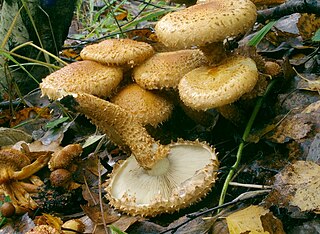
Pholiota is a genus of small to medium-sized, fleshy mushrooms in the family Strophariaceae. They are saprobes that typically live on wood. The genus has a widespread distribution, especially in temperate regions, and contains about 150 species.

The Physalacriaceae are a family of fungi in the order Agaricales. Species in the family have a widespread distribution, ranging from the Arctic, (Rhizomarasmius), to the tropics, e.g. Gloiocephala, and from marine sites (Mycaureola) and fresh waters (Gloiocephala) to semiarid forests (Xerula).
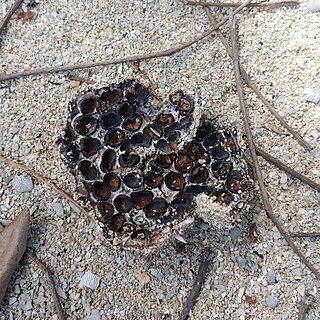
Diplocystis is a genus of fungi in the Diplocystaceae family. The single species in the genus, Diplocystis wrightii, has been shown using phylogenetic analysis to be a member of the Sclerodermatineae suborder of the Boletales. The species was originally described in 1869 by Miles Joseph Berkeley and Moses Ashley Curtis, from specimens collected in the Caribbean.
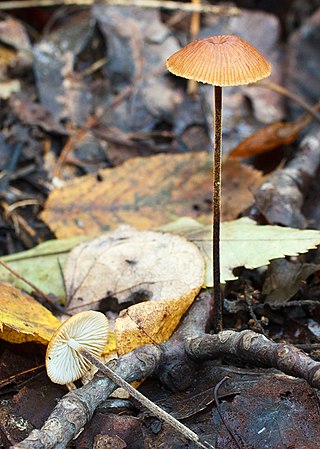
Rhizomarasmius is a genus of fungi in the family Physalacriaceae, containing about five species.

Marasmiellus is a genus of fungi in the family Omphalotaceae. The widespread genus, circumscribed by American mycologist William Murrill in 1915, contains over 250 species. The name comes from the Greek marasmus meaning wasting.

Mycetinis is a genus of fungus in the Omphalotaceae family, containing about eight species formerly classified in Marasmius.

Deconica coprophila, commonly known as the dung-loving psilocybe, meadow muffin mushroom, or dung demon, is a species of mushroom in the family Strophariaceae. First described as Agaricus coprophilus by Jean Baptiste François Pierre Bulliard in 1793, it was transferred to the genus Psilocybe by Paul Kummer in 1871. In the first decade of the 2000s, several molecular studies showed that the Psilocybe was polyphyletic, and the non-bluing (non-hallucinogenic) species were transferred to Deconica.

Dacryopinax elegans is a species of jelly fungus in the family Dacrymycetaceae. It was originally formally described as Guepinia elegans by Miles Berkeley and Moses Ashley Curtis in 1849. George Willard Martin transferred it to the genus Dacryopinax in 1948.
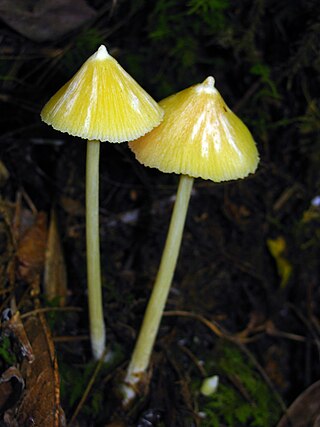
Entoloma murrayi, commonly known as the yellow unicorn Entoloma or the unicorn pinkgill, is a species of fungus in the Entolomataceae family. First described from New England (USA) in 1859, the species is found in eastern North America, Central and South America, and southeast Asia, where it grows on the ground in wet coniferous and deciduous forests. The fungus produces yellow mushrooms that have a characteristic sharp umbo on the top of a conical cap. The mushroom is inedible and may be poisonous. Other similar species can be distinguished from E. murrayi by differences in color, morphology, or microscopic characteristics.
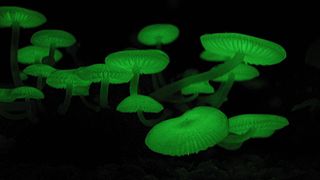
Mycena chlorophos is a species of agaric fungus in the family Mycenaceae. First described in 1860, the fungus is found in subtropical Asia, including India, Japan, Taiwan, Polynesia, Indonesia, and Sri Lanka, in Australia, and Brazil. Fruit bodies (mushrooms) have pale brownish-grey sticky caps up to 30 mm (1.2 in) in diameter atop stems 6–30 mm (0.2–1.2 in) long and up to a millimeter thick. The mushrooms are bioluminescent and emit a pale green light. Fruiting occurs in forests on fallen woody debris such as dead twigs, branches, and logs. The fungus can be made to grow and fruit in laboratory conditions, and the growth conditions affecting bioluminescence have been investigated.

Flammula is a dark brown-spored genus of mushrooms that cause a decay of trees, on whose bases they often fruit, forming clusters of yellowish brown mushrooms.
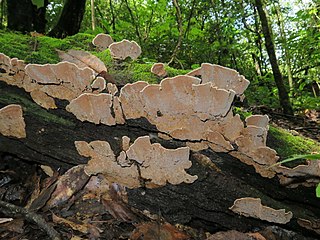
Xylobolus subpileatus is a widely distributed species of crust fungus in the family Stereaceae. It was first described scientifically in 1849 by Miles Joseph Berkeley and Moses Ashley Curtis, who considered the fungus a species of Stereum closely related to but distinct from Stereum rugosum. The original collections were made from specimens growing on dead trunks in the United States of Ohio and South Carolina. Xylobolus subpileatus was given its current name by French mycologist Jacques Boidin when he transferred it to the genus Xylobolus in 1958.

Mycetinis scorodonius is one of the garlic-scented mushrooms formerly in the genus Marasmius, having a beige cap of up to 3 cm and a tough slender stipe.
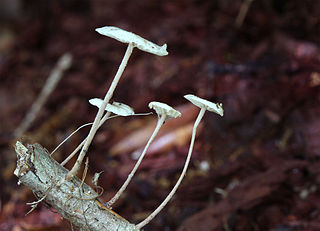
Mycetinis querceus is one of the garlic-scented mushrooms formerly in the genus Marasmius. It has a reddish brown stipe, and usually grows on fallen oak leaves.

Mycetinis kallioneus is a mushroom formerly in the genus Marasmius, which grows with dwarf shrubs and flowering plants in an arctic environment where the ground is covered by snow for much of the year.
Dennis Edmund Desjardin is an American mycologist. He has been called the "Mushroom Guru of the West Coast".

















